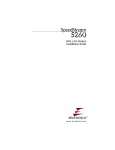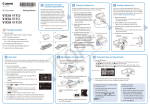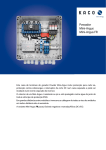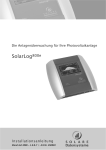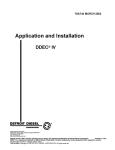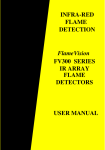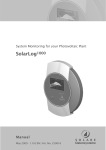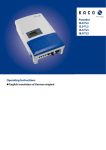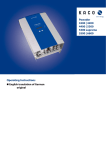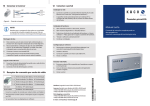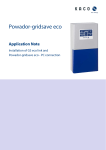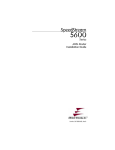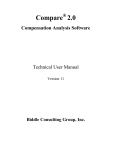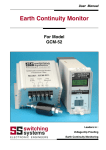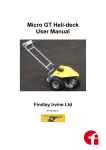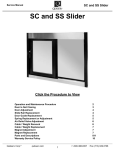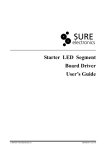Download Installation Procedure Part 1 0f 3
Transcript
IP0011-12 Installation Procedure Issue Date – 15/01/2013 Confidential SWIFT SWIFT WIND ENERGY SYSTEM™ Installation Procedure TO BE INSTALLED BY COMPETENT PERSONNEL ONLY Page 2 Renewable Devices Ltd: www.renewabledevices.com IP0011-12 Installation Procedure Issue Date – 15/01/2013 Confidential Document Issue Record Document IP0011-13 Originally Renewable Devices prepared by Date Purpose of issue & amendment Released by 01 27/11/11 Initial Issue Renewable Devices Ltd 13 25/01/2013 General Revision Version Renewable Devices Ltd Page 3 Renewable Devices Ltd: www.renewabledevices.com Table of Contents 1. Definitions and Abbreviations ....................................................................................................... 6 2. Notes to Installers............................................................................................................................... 7 2.1. 2.2. 2.3. 2.4. Wind loading ................................................................................................................................................ 7 Installer Training ....................................................................................................................................... 8 Site Survey / Training............................................................................................................................... 8 Documentation............................................................................................................................................ 9 Installation Procedure Overview ....................................................................................................... 10 3. Unpacking and Inspection of System ........................................................................................ 12 3.1. 4. Electrical Component Check – Test E1: ............................................................................................12 Installation of Wall Mounting System ...................................................................................... 15 4.1. 4.2. 4.3. 5. Bracket Positions and Marking Up ....................................................................................................15 Hydraulic Pull Test (Test M1) ..............................................................................................................16 Installing the Brackets and Mast ........................................................................................................17 Nacelle Assembly ............................................................................................................................. 18 5.1. 5.2. 5.3. Lifting the Nacelle ....................................................................................................................................18 Fitting the Nacelle Clamp.......................................................................................................................18 Fitting the Mast Cable Connector Block ...........................................................................................19 6. Fitting the Fins and Booms ........................................................................................................... 20 7. DC Connections ................................................................................................................................. 21 7.1. 7.2. 7.3. 7.4. 8. Earthing .......................................................................................................................................................21 Connection of Mast and Mast Cable to DC Isolator .......................................................................22 Continuity Testing – DC Wiring (Test E2) ........................................................................................23 DC Installation Test (Test E3) ..............................................................................................................24 Grid Tie Inverter – Mounting and DC Connection ................................................................ 27 8.1. 8.2. 9. Mounting .....................................................................................................................................................27 Inverter Connections to the DC Isolator ..........................................................................................27 Grid Tie Inverter – AC Connection ............................................................................................. 29 9.1. 9.2. AC Isolator Installation ..........................................................................................................................30 Inverter Test (Test E4) ...........................................................................................................................31 10. Fitting of Rotor and Nose Cone ............................................................................................... 32 11. Commissioning and Handover ................................................................................................ 33 12. Appendix A Tools and Consumables ..................................................................................... 34 12.1. Appendix B Consumable Items / Spares ..........................................................................................36 13. Appendix C Swift Inverter......................................................................................................... 38 13.1. 13.2. 13.3. 13.4. Swift Inverter – Mast Cable Connector .............................................................................................38 Swift Inverter – Brake Release & DC Voltage Test (Test E1) ....................................................38 Swift Inverter – Mounting .....................................................................................................................39 Swift Inverter – Continuity Testing – DC (Test E2).......................................................................40 IP0011-12 Installation Procedure Issue Date – 07/06/2012 Confidential 13.5. 13.6. 13.7. 13.8. Swift Inverter –DC Isolator Switch Function Test (Test E3) .....................................................41 Swift Inverter – Connections to the DC Isolator ............................................................................42 Swift Inverter – Wireing & Earthing ..................................................................................................43 Swift Inverter – Swift Inverter Test (Test E4) ................................................................................44 14. Appendix D Wooden Pole Installation ................................................................................. 45 15. The drawing SC0018 within Appendix F Installation Certificate ID0019-01 ......... 46 15.1. 15.2. 15.3. 15.4. 15.5. 16. Wooden Pole – Mast Cable ....................................................................................................................51 Wooden Pole – Nacelle ...........................................................................................................................51 Wooden Pole – Cable & Earth...............................................................................................................52 Wooden Pole – Brake Release and DC Voltage Test (Test E1) .................................................53 Wooden Pole – DC Connections ...........................................................................................................54 Appendix E SSEG Commissioning Sheet ............................................................................... 55 SSEG Commissioning Confirmation ................................................................................................... 56 17. Appendix F Installation Certificate ID0019-01 ................................................................. 61 18. Appendix G SC0016, SC0018 & Technical Drawings ....................................................... 66 Page 5 Renewable Devices Ltd: www.renewabledevices.com IP0011-12 Installation Procedure Issue Date – 07/06/2012 Confidential 1. Definitions and Abbreviations AC Alternating Current CSA Cross Sectional Area CWS Gland rating that must be used DC Direct Current DNO Distribution Network Operator I+ Inverter positive I- Inverter negative Is Inverter signal MCS Microgeneration Certification Scheme PSU Power Supply RD Renewable Devices Ltd SSEG Small Scale Embedded Generator SWA Steel Wire Armoured Cable S Signal line T+ Turbine positive T- Turbine negative TS Turbine signal Page 6 Renewable Devices Ltd: www.renewabledevices.com IP0011-12 Installation Procedure Issue Date – 07/06/2012 Confidential 2. Notes to Installers Drawings in Appendix F Installation Certificate ID0019-01 Complete one certificate per turbine and return to Renewable Devices Ltd within 28 days of commissioning. Incomplete or absent Installation Certificates will void the manufacturer’s warrantee. The installer is responsible for ensuring that the most up to date installation specification is used. 2.1. Wind loading Wind loading on a wind turbine represents a significant force. Forces given in the following appendix represent Maximum wind loadings. The maximum thrust loading to which all structures, mounting systems or foundations must be designed is 7kN horizontal thrust from any direction at the nacelle hub height. Be aware that the bending moment at the base of the turbine tower will be significant. The stiffness of the whole structure opposing this thrust load must be greater than 25N/mm at the turbine hub height. (This same design parameter can also be described as a maximum structural compliance of 0.04mm/N at the turbine hub) Page 7 Renewable Devices Ltd: www.renewabledevices.com IP0011-12 Installation Procedure Issue Date – 07/06/2012 Confidential • Appendix G SC0016, SC10018 & Technical Drawings give an overview of the components of the turbine. • Unless otherwise agreed in writing with Renewable Devices, all aspects of the installation must conform to these drawings and to this installation procedure. • The user manual PD0017 describes the operation of an installed Swift Rooftop Wind Energy System™. • Before proceeding with the installation, check that your Swift Rooftop Energy System™ has been shipped with a Kaco Powador 2002 inverter. If this is not the case, consult Appendix C Swift Inverter installation procedure • Prior to commencing any work confirm that the documentation used is the current version for the Swift system to be installed. • For the warranty to be valid all the documentation specified in a completed Appendix F Installation Certificate ID0019-01 must be returned within 28 days of commissioning the turbine. 2.2. Installer Training • No installation of the Swift Rooftop Energy System should be carried out without prior accreditation to or similar to those required by the UK MCS accreditation Scheme, Energy Savings trust or LCBP. Experience in wind turbine resource assessment, Wind turbine siting and installing and commissioning Grid tie inverters to the 17th edition of the UK IEE Wiring regulations are essential. • This installation procedure is intended as guidance for qualified installers only. 2.3. Site Survey / Training • Prior to installation a site survey including resource assessment and structural assessment must be carried out. • RD Energy Solutions, a consultancy division in the Renewable Devices Group of companies can offer training site surveys and installation if requested. Page 8 Renewable Devices Ltd: www.renewabledevices.com IP0011-12 Installation Procedure Issue Date – 07/06/2012 Confidential 2.4. Documentation The following documents accompany the installation procedure. • Owners Manual PD0017 • Appendix E SSEG Commissioning Sheet • Appendix F Installation Certificate ID0019-01 • Appendix G SC0016, SC0018 & Technical Drawings The following documents are also required. • ETA-02/0024 Fischer resin anchor instructions (FIS V 360 resin system) • Fischer resin data sheet • Fischer loadings and structure assessment docs • BS 5080-1:1993 - Structural fixings in concrete and masonry. Method of test for tensile loading • Kaco New Energy Powador 2002 User & Installation manual – Wind • CE72 - Installing small wind-powered electricity generating systems, Guidance for installers and specifiers • BS 7671 - IEE Wiring Regulations, 17th Edition or the relevant local regulations The following forms must be completed and returned to the relevant organisations. Without the return of these documents the Swift turbine warranty is invalid and the installation bay be illegal. • Appendix E SSEG Commissioning Sheet to the local DNO • Appendix F Installation Certificate ID0019-01 to Renewable Devices Ltd Page 9 Renewable Devices Ltd: www.renewabledevices.com IP0011-12 Installation Procedure Issue Date – 07/06/2012 Confidential Installation Procedure Overview Notes: • The table below and on the following pages gives an overview of the installation process and refers to the documentation that must be completed at each stage in the process. • Unless otherwise specified all results should be recorded on ID0019. Section Actions N/A Supporting Docs • Perform a Site survey • Check that the turbine can be Record Results SC0016 installed as described in the site survey and this procedure. 5 6 Check all components are present SC0016 • Site details and in good condition. • Serial numbers • Test nacelle and power supply. • E1 test results • Record serial numbers. • Install mounting studs & wait for SC0016 cure - up to 24 hours BS 5080-1 • M1 test results • Mounting • (temperature dependant) • Carry out hydraulic load test to BS 5080-1 (Test M1). • SC0016 Install brackets and mast system 7 SC0016 • Fit nacelle to mast. • Fit mast cable. • Carry out brake release test and DC voltage test (Test E1). Continued on next page. Page 10 Renewable Devices Ltd: www.renewabledevices.com • E1 test results IP0011-12 Installation Procedure Issue Date – 07/06/2012 Confidential Section Actions Supporting Docs 8 • Fit fins and booms to nacelle. SC0016 9 • Connect SWA from mast to DC SC0016 Record Results • E2 test results • E3 test results • E4 test results • E5 test results • Electrical isolator. Test DC wiring (Test E2). • Test function of DC isolator (Test SC0016 E3). 10 • Test the DC installation (Test E4) • Mount the inverter Kaco • Connect the DC isolator to the Manual Powador 2002 inverter 11 SC0016 • Install the AC isolator • Connect and test AC wiring from distribution board to inverter system (requires qualified electrician). 12 13 • Inverter Test (Test E5) • Fit rotor. • Fit nose cone • Observe turbine function • Provide customer with Owners PD0017 Manual. ID0019 Return ID0019 & SSEG Sheet to SSEG Sheet • SC0016 Rotor installation Renewable Devices N/A • • Send SSEG Sheet to the DNO. • Continue to check and monitor turbine performance. Page 11 Renewable Devices Ltd: www.renewabledevices.com IP0011-12 Installation Procedure Issue Date – 07/06/2012 Confidential 3. Unpacking and Inspection of System Notes: • Prior to commencing with the installation, all of the components of the system should be inspected for signs of shipping damage and the serial numbers recorded on Appendix F Installation Certificate ID0019-01. • If a component is damaged in shipping, the warranty will be void. 3.1. Electrical Component Check – Test E1: Notes: • This test confirms that the Swift nacelle has not been damaged in transit and the 12V power supply is functioning correctly. • Making incorrect connections during this test may result in false positives and irreparable damage to the on-board-electronics. • This test should be performed with the nacelle still in its original polystyrene packaging on a level surface, if performed at an angle the on-board acceleration switch will lock the turbine brake on, requiring a reset. Page 12 Renewable Devices Ltd: www.renewabledevices.com IP0011-12 Installation Procedure Issue Date – 07/06/2012 Confidential 3.1.1. PSU 12V test: • Yellow (S) Connect a lead and socket to the 12V PSU but do Grey (-) NOT connect to the mains. • • Brown (+) Connect leads to the PSU: • Grey 1.5mm2 to PSU negative • Yellow 1.5mm2 to PSU positive Connect these to a terminal block with appropriate test points attached as indicated in the photo. • Connect a multimeter set to read dc voltage across the –ve and +ve test points from the 12V PSU (grey and yellow wires respectively) • Briefly connect the 12V PSU to the mains to confirm that it outputs 12V. 3.1.2. Brake test set-up: • Connect the mast cable to the terminal bock. • Connect the positive output of the 12V PSU to the signal line [Lead 3], the negative to the DC negative of the nacelle [Lead 1], and the positive of the nacelle [Lead 2] to the remaining test point on the terminal block. • Connect a multimeter set to read DC voltage to the DC negative and positive of the nacelle at the test points connected to the terminal block. Page 13 Renewable Devices Ltd: www.renewabledevices.com IP0011-12 Installation Procedure Issue Date – 07/06/2012 Confidential 3.1.3. Brake release test: • Yellow (S) Confirm that the brake is active by turning the Grey (-) shaft of the nacelle: a pulsing resistance should Brown (+) be felt. • Connect the 12V PSU to the mains. • Confirm that the brake has been released by turning the shaft of the nacelle: very little resistance should be felt. • Confirm that a voltage is produced across the DC negative and positive of the nacelle and that the polarity is as expected while turning the shaft of the nacelle. • Disconnect the 12V PSU and confirm that the brake has been reapplied. • 3.1.4. Record the results on sheet ID0019– Test E1 Resetting the turbine: • If the brake is not released disconnect the 12V PSU from the mains. Reverse the connections from the PSU at the terminal block, so that the Yellow (S) 12V PSU positive is connected to the nacelle Grey (-) negative (#1) and the PSU negative to the Brown (+) nacelle signal (#3). This reversal effectively provides a –ve 12 signal which resets the nacelle safety systems. • Connect the 12V PSU to the mains for approximately 5 seconds. • Repeat 3.1.2 & 3.1.3, the brake should now release and reapply. If the break does not release ensure nacelle is laying flat in its packaging if the break does not reset return the turbine to your distributor and repeat the Reset. Page 14 Renewable Devices Ltd: www.renewabledevices.com IP0011-12 Installation Procedure Issue Date – 07/06/2012 Confidential 4. Installation of Wall Mounting System 4.1. Bracket Positions and Marking Up Notes: • See sheet 3 of SC0016 for the correct bracket positions and for the rotor position relative to the top bracket and roof ridgeline. • The brackets are attached to the wall using a Fischer resin anchor system. • The resin anchors should be installed in accordance with the directions given in the Fischer documents; these can be found through the Fischer website: www.fischer.co.uk, and searching for details relating to “injection cartridge FIS V” on their online catalogue. • The Fischer document ETA-02/0024 should be read in its entirety prior to commencing an installation. • The depth and diameter requirements for the holes specified (14 mm diameter x 250 mm depth) are typical for most masonry but may need to be modified following consultation with a structural engineer. • Contact Fischer if there is any doubt over the hole requirements or installation technique. • If the proposed siting of the turbine is not as described in the structural survey then it should be re-examined before work proceeds. 4.1.1. • Mark out the positions of the holes for the resin anchors using a plumb-line, tape measure and spirit level. • Pay close attention to sheet 3 of SC0016. It may be necessary to move a bracket position up or down within the given tolerances to ensure that the anchors are fixed to solid brick/block/stone and not into mortar. 4.1.2. • Install the Fischer resin anchors in accordance with the Fisher documentation. Page 15 Renewable Devices Ltd: www.renewabledevices.com IP0011-12 Installation Procedure Issue Date – 07/06/2012 Confidential 4.2. Hydraulic Pull Test (Test M1) Notes: • Once the stud has cured, each stud should be tested using a portable tension tester / hydraulic load tester. • Tests should be carried out to BS 5080-1:1993 (Structural fixings in concrete and masonry. Method of test for tensile loading.) 4.2.1. • Test pull each stud to 13kN • If a stud fails: 1. Grind the stud off. 2. Reposition the bracket within the tolerances of sheet 3 of SC0016. 3. Test again after curing. • Record the test results on the commissioning sheet ID0019. Page 16 Renewable Devices Ltd: www.renewabledevices.com IP0011-12 Installation Procedure Issue Date – 07/06/2012 Confidential 4.3. Installing the Brackets and Mast Notes: • See sheets 1 and 4 of SC0016 for details of the bracket assembly and tightening torques. • It is the installer’s responsibility to ensure that all lifting is carried out safely. The mass of the pole is 40 kg. • Depending on the lifting method used, it is recommended to assemble 3 of the 4 brackets to the wall and one to the pole. 4.3.1. • Fit the rubber bushes to the lower mounting brackets. • Attach the lower mounting bracket to the spacer bracket. • Fix three of these part completed assemblies to the bottom three sets of Fischer resin anchors. • Fix the entire top bracket assembly to the pole at the position shown in the wallmounting diagram on sheet 3 of SC0016. 4.3.2. • Once the top bracket is secured and the bolts correctly tightened it can be used as a lifting point. • Use an appropriate lifting arrangement to lift the pole so that the top bracket assembly can be fitted to the top pair of Fischer M12 Anchor bolts. 4.3.3. • Fit the M12 Nylock nuts to secure the pole. • The mast should now be in position on the remaining 3 clamps. • Bolt on the front parts of the clamps to secure it to the wall. • Ensure threadlock is applied and all nuts and bolts are tightened to the correct torque settings as detailed on sheet 1 of SC0016. • Sign off the mounting installation section of the commissioning sheet ID0019. Page 17 Renewable Devices Ltd: www.renewabledevices.com IP0011-12 Installation Procedure Issue Date – 07/06/2012 Confidential 5. Nacelle Assembly Notes: • See sheets 1 and 5 of SC0016 for details of the nacelle assembly and tightening torques. 5.1. Lifting the Nacelle Notes: It is the installer’s responsibility to ensure that all lifting is carried out safely. The mass of the nacelle is 35Kg. 5.1.1. • The end of the mast cable should be lowered down the length of the mast. • Ensure that there is sufficient cable to reach the connector at the bottom of the mast with approx 300mm spare. 5.1.2. • Adjust the working platform to a comfortable height before lifting the nacelle onto the pole. • Lower the nacelle taking care not to trap wires between the base of the nacelle clamp and the top of the pole. • Ensure that no strain is put on the mast cable. 5.2. Fitting the Nacelle Clamp 5.2.1. • Swivel the base of the nacelle so the pre-drilled hole in the aluminium pole lines up with the hole provided in the nacelle base for the M10x20 retaining bolt. • The nacelle clamp is tightened using the 8 M6x40 cap screws. • Apply thread lock to all the bolts and observe the correct torque sequence as illustrated on sheet 5 of SC0016. • Tighten all bolts lightly at first so that there is an even spacing on both sides of the nacelle clamp. Page 18 Renewable Devices Ltd: www.renewabledevices.com IP0011-12 Installation Procedure Issue Date – 07/06/2012 Confidential 5.3. Fitting the Mast Cable Connector Block 5.3.1. • At the base of the mast, connect the mast cable to the connector block (Part 150 0016). • Ensure that there is at least 300mm cable spare below the mast. Page 19 Renewable Devices Ltd: www.renewabledevices.com IP0011-12 Installation Procedure Issue Date – 07/06/2012 Confidential 6. Fitting the Fins and Booms Notes: • See sheets 1 and 7 of SC0016 for details of the fin and boom assembly and tightening torques. 6.1.1. • Apply thread-lock to all fixings. • Fit each of the boom clamps with 2 M6x30 cap screws and 1 M6x60 cap screw with the M6 Staytite flanged nut to the booms. • Tighten all bolts lightly so that there is an even spacing on both sides of the boom clamp and then tighten to the required torque. 6.1.2. 6.1.3. • Attach each fin using 4 M6x16 bolts. • Thread-lock and tighten to the required torque. • Fit the boom and fin assembly to the nacelle. • The boom with the hinged furling mechanism MUST BE placed into the right hand slot on the nacelle as viewed from behind the nacelle. • Check that fins are vertical before finally tightening the nacelle clamps to the required torque. 6.1.4. • On completion of the nacelle, fin and boom installation, sign off the relevant section of the commissioning sheet ID0019. Page 20 Renewable Devices Ltd: www.renewabledevices.com IP0011-12 Installation Procedure Issue Date – 07/06/2012 Confidential 7. DC Connections 7.1. Earthing Notes: • The correct earthing arrangement for the turbine nacelle and mast is dependant on site specific factors. See sheet 7 of SC0016 for earthing notes. • All earthing should be in accordance with BS 5176: 17th Edition. • The recommendations in CE72 - Installing small wind-powered electricity generating systems, guidance for installers and specifiers should be followed to comply with the UK MCS requirements. • A mast earth must be provided in accordance with CE72 and all applicable local regulations. • As general guidance, the shielding of the DC SWA should be bonded to the mast. • If a Lightning Protection System (LPS) is installed or the appropriate earthing arrangement is ambiguous then advice should be sought from a qualified electrical contractor. Page 21 Renewable Devices Ltd: www.renewabledevices.com IP0011-12 Installation Procedure Issue Date – 07/06/2012 Confidential 7.2. Connection of Mast and Mast Cable to DC Isolator Notes: The DC isolator is supplied with the Swift Turbine. This is not a standard isolator and should not be substituted with any other isolator. See sheets 8 and 9 of SC0016 for an overview of the DC wiring. Incorrect wiring can cause irreparable damage to the systems electronics. All DC wiring to be rated minimum 600V DC to earth, 1000V DC between conductors and rated for a minimum of 10A • Three phase SWA has the correct colours for DC wiring harmonised regulations. The black core should be taped or heat shrunk in yellow at both ends to indicate that it is the signal cable. • The gland for the SWA MUST be below the lowest bracket, any other position will compromise the integrity of the turbine pole. 7.2.1. 7.2.2. 7.2.3. • Mount the DC Isolator on a wall close to the intended position of the grid tie inverter. • Decide on an appropriate position on the mast for the SWA gland (CW 20S). • The gland MUST be below the lowest bracket. • Drill and tap for the gland. (For a 20S brass gland, thread is normally M20x1.5.) • Strip back the sheath and armour so that there is sufficient length for the cores to be dropped and connected at the bottom of the pole. 7.2.4. • Connect the cores of the SWA cable to the connector block at the bottom of the mast. • Once the connections are complete, push the connector block back up into the pole and fit the end cap provided. 7.2.5. • Connect the three cores of the SWA cable to the T-, T+ and TS terminals of the DC isolator. Page 22 Renewable Devices Ltd: www.renewabledevices.com IP0011-12 Installation Procedure Issue Date – 07/06/2012 Confidential 7.3. Continuity Testing – DC Wiring (Test E2) Notes: This test MUST be carried out before the connection is made to the inverter. A short circuit in the DC wires can cause permanent damage to the inverter or electronics in the nacelle. DO NOT use a megger tester for this test, as it will damage the turbine electronics. 7.3.1. • Prior to commencing this test the following should be confirmed: The wiring from the DC isolator to the nacelle is complete The wiring from the DC isolator to the inverter is not connected The DC isolator is in the OFF position. 7.3.2. • Using a multimeter, check the resistance across the three DC wires (T+, T-, TS) on the turbine side of the DC isolator and between these three wires and the turbine earth. • There should be no continuity between any pair of wires or between the wires and the mast earth. • The resistance value seen on the multimeter may not be stable, but in all cases should be greater than 0.7MΩ apart from to earth, which should show a stable open loop. 7.3.3. 7.3.4. • Additionally check for continuity between the DC wiring and earth using a multimeter. • There should be no continuity between any of the DC wiring and earth. • Record the results of the test (Test E2) on the commissioning certificate ID0019. Page 23 Renewable Devices Ltd: www.renewabledevices.com IP0011-12 Installation Procedure Issue Date – 07/06/2012 Confidential 7.4. DC Installation Test (Test E3) Notes: • This test must be carried out with the nacelle and mast cable installed and the SWA is connected to the connector block. 7.4.1. Test set-up: • Connect a connector block via short lengths of correctly colour-coded wire to the inverter side connections of the DC isolator: • Signal (IS) – yellow • DC positive (I+) – brown • DC negative (I-) – grey Grey (-) Yellow (S) to nacelle 7.4.2. 7.4.3. Brake confirmation: • Rotate shaft of the turbine clockwise. • The shaft should rotate with a pulsed resistance, confirming that the brake is applied. Multimeter connection: • Replace the cover of the DC isolator. • Set a multimeter to read DC voltage. • Connect it between the DC positive [I+] and Negative [I] lines at the connector block. Brown (+) Page 24 Renewable Devices Ltd: www.renewabledevices.com Grey (-) Yellow (S) IP0011-12 Installation Procedure Issue Date – 07/06/2012 Confidential 7.4.4. Brake release: • Using the same configuration as in section 5.1.1 (12V PSU test) connect the 12V PSU: • 12V PSU positive to signal. • 12V PSU negative to DC negative. • Set the DC isolator to “ON”. • This should release the brake while the voltage is applied. Brown (+) 7.4.5. 7.4.6. Yellow (S) Brake release confirmation: • Rotate the shaft. • There should be a smooth action, indicating that the brake has successfully released. Brake reset: • 7.4.7. Grey (-) If the brake is not released: • Rotate the DC isolator to “RESET” and hold for 5 seconds. • Return the isolator to “ON”. • Repeat 9.4.5. Un-braked operation check: • When the shaft is rotated by hand, a voltage should be present between the DC lines, which will show on the multimeter, indicating correct operation. 7.4.8. • Check the polarity of the DC voltage is correct. • Return the DC isolator to the “OFF” position. • Disconnect the test equipment. Result recording: • If either Brake release conformation or Un-braked operation check do not produce the expected results then the electrical tests should be repeated in reverse order to try Page 25 Renewable Devices Ltd: www.renewabledevices.com IP0011-12 Installation Procedure Issue Date – 07/06/2012 Confidential and determine the location of the installation fault and remedial action taken as necessary. • Record the results of the test (Test E3) on the commissioning certificate ID0019. Page 26 Renewable Devices Ltd: www.renewabledevices.com IP0011-12 Installation Procedure Issue Date – 07/06/2012 Confidential 8. Grid Tie Inverter – Mounting and DC Connection Notes: • This manual is intended to supplement the Kaco Powador 2002 User & Installation manual supplied with the inverter only, NOT replace it. • Read the complete Powador 2002 manual before installing the inverter. • Mount the inverter in accordance with the Powador 2002 manual. 8.1. Mounting Notes: • The procedure to install the inverter is described in section 7 of the Kaco Powador 2002 manual. • The exact position of the inverter should be discussed with the customer and must comply with the recommendations made in section 7.1 of the Powador 2002 manual. Consideration should also be made to accessibility for service. 8.2. Inverter Connections to the DC Isolator Notes: • Unless otherwise specified cable used should be of the same CSA as used for the run between the Turbine and DC isolator as specified in SC0016 sheet 8. • If the printed markings on the switch are different to those indicated here, contact Renewable Devices before proceeding. Page 27 Renewable Devices Ltd: www.renewabledevices.com IP0011-12 Installation Procedure Issue Date – 07/06/2012 Confidential 8.2.1. • Ensure that the top side of the isolator, which has the T+ and I+ terminals, is wired as indicated: • o T+ (turbine positive) to the turbine DC positive o TS (turbine signal) to the turbine signal o T- (turbine negative) to the turbine DC negative Make a connection between: o 8.2.2. • I+ (inverter positive) and the Kaco’s lower DC + terminal with brown cable On the bottom side of the isolator make connections between: o IS (inverter signal) to the right “ERR” terminal in the Kaco using 1.5mm² yellow cable and the supplied connector. o I- (inverter negative) to the Kaco’s lower “DC –“ terminal with grey cable Page 28 Renewable Devices Ltd: www.renewabledevices.com IP0011-12 Installation Procedure Issue Date – 07/06/2012 Confidential 9. Grid Tie Inverter – AC Connection Notes: • Before the AC connections are made, the DC tests described in section 7 must be completed. • All connections should be made in accordance with the Kaco Powador 2002 User & Installation manual with the exception of the AC isolator as specified in section 9.1; this must be installed in addition to any other connection requirements specified by the Powador 2002 manual or local wiring regulations. • The AC connections must be made and tested by a qualified electrician. • The AC connections must be made as shown in sheets 8 and 9 of SC0016. AC wiring must be rated for normal 240V AC operation. AC conductors must be rated for 10A rms and not less than 1.5 mm² CSA. IMPORTANT!! AC conductors to be sized for maximum 4% voltage drop. Most cable suppliers can provide look up tables to allow cables to be sized correctly. Circuit protective conductor to be “high integrity” as per BS7671, section 607-02-04(i) (17th Edition) Page 29 Renewable Devices Ltd: www.renewabledevices.com IP0011-12 Installation Procedure Issue Date – 07/06/2012 Confidential 9.1. AC Isolator Installation Notes: • The AC isolator also houses the 12V PSU used during the previous tests. • Connection from the AC isolator to the grid/distribution board should only be competed once the DC Connections have been made, and is described in section 10. 9.1.1. 9.1.2. • Mount the AC Isolator on the wall. • Mount the 12V PSU on the Din rail to the right of the isolator. • Make connections from the inverter side of the isolator to the PSU according to sheet 9 of SC0016 using 1.5mm2 appropriately coloured cables. 9.1.3. • Connect the isolator to the AC connections of the inverter according to sheet 9 of SC0016 • Connect the PSU DC negative to the top inverter DC Negative terminal using 1.5mm2 grey cable. • Connect the PSU DC positive to the left Inverter “ERR” terminal using 1.5mm2 yellow cable and the supplied connector. Page 30 Renewable Devices Ltd: www.renewabledevices.com IP0011-12 Installation Procedure Issue Date – 07/06/2012 Confidential 9.2. Inverter Test (Test E4) Notes: • Ensure that the DC isolator is in the OFF position. • From powering on the inverter for the first time the installer has ten minutes to change the country and language settings before these are locked. The Powador 2002 manual must be referred to and followed to ensure correct inverter installation and configuration. 9.2.1. • Follow the instructions in section 7.8.2 of the Powador 2002 manual, but with the DC isolator in the OFF position. . 9.2.2. • Check that the OK light comes on as soon as the inverter is connected to the grid. • Enter the country and language settings as described in section 7.8.2 of the the Powador 2002 manual (default is German). 9.2.3. • After several minutes, check that the grid connection indicator is green (as shown in section 7.8.3). 9.2.4. • Press keys 1 and 2 simultaneously as explained in section 8.3 of the Powador 2002 manual and write down the DSP and MC software versions in ID0019. • If all of the electrical tests have been passed, the electrical section of the commissioning sheet can now be signed off. Page 31 Renewable Devices Ltd: www.renewabledevices.com IP0011-12 Installation Procedure Issue Date – 07/06/2012 Confidential 10. Fitting of Rotor and Nose Cone Notes: • Lock the DC isolator in the OFF position while installing the rotor and nosecone. • See sheets 1 and 10 of SC0016 for the assembly method and tightening torques for the rotor. • Do not install the rotor and nosecone until all of the electrical connections and tests are completed and signed off. With the brake released, the rotor can spin-up freely and may generate up to 400V across the DC lines. This can present a safety risk during connection as well as a risk of equipment damage if the lines are shorted. 10.1.1. • Place the key into the slot on the shaft of the nacelle and tap it into place gently. • Lift the rotor on to the shaft (make sure the taper of the hole on the shaft adapter matches the taper of the shaft) and push into place. • Fit the M30 washer and Staytite nut and tighten to the torque shown on sheet 1 of SC0016. • Once the Staytite nut has been tightened to the required torque check that the key cannot be seen protruding from the nacelle side of the rotor and that the rotor is securely mounted on the shaft. 10.1.2. • Fit the nose cone by clipping it over the front of the rotor. • Excessive force will break the clips; it should be gently pushed over the roots of the blades. 10.1.3. • Sign off the rotor installation section of the commissioning sheet ID0019. Page 32 Renewable Devices Ltd: www.renewabledevices.com IP0011-12 Installation Procedure Issue Date – 07/06/2012 Confidential 11. Commissioning and Handover Notes: • The warranty for the turbine is not valid unless the commissioning sheet ID0019 has been completed correctly and returned. 11.1.1. 11.1.2. • Switch the DC isolator to the BRAKE and then the ON position. • See the Owners Manual PD0017 for a description of the functioning of the turbine and inverter. 11.1.3. 11.1.4. • If the wind is sufficient for the turbine to generate, check power generation. • Explain the functioning of the turbine to the customer. • Hand over the Owners Manual PD0017 to the customer. • Hand over the Kaco Powador 2002 User & Installation manual to the customer. • Ensure that the commissioning sheet ID0019 is complete. • Complete the SSEG commissioning sheet and return this to the DNO and Renewable Devices. • Return a copy of the commissioning sheet ID0019 to Renewable Devices. Page 33 Renewable Devices Ltd: www.renewabledevices.com IP0011-12 Installation Procedure Issue Date – 07/06/2012 Confidential 12. Appendix A Tools and Consumables This list is not exhaustive. Common tools found in an electrical and general tool kit will be required. Page 34 Renewable Devices Ltd: www.renewabledevices.com IP0011-12 Installation Procedure Issue Date – 07/06/2012 Confidential TOOL General TASK Tools listed in sheet 1 of SC0016. Torque wrenches, range 5-40Nm Slings > 2 tonne, shackles, rope and other lifting equipment as required All Full range of ring spanners Mobile pull tester rated to 13kN e.g. Hydra – Brackets jaws All aspects of turbine installation Lifting pole and nacelle aspects of turbine of turbine installation All aspects installation Pull testing resin anchors Resin anchors Laser level; chalk line; spirit level Vertical alignment 18.5mm HSS metal drill bit SWA cable gland M20 x 1.5 hand tap Armoured cable gland (>300mm) Extra long 16 to 20 mm masonry drill bit Electrical screwdrivers; wire strippers; crimping tools. Rotor & Nose Cone turbine Fischer resin gun M16 & M14 masonry drill bit and hammer drill Electrical of installation Full range of allen hex key and hex socket All adapter for use with torque wrench aspects Resin anchors Armoured cable (15mm OD) through walls Electrical installation 2mm, 2.5mm Allen hex key panel on inverter Fluke multimeter and spare battery Electrical tests Socket and lead Electrical tests 46mm socket or ring spanner M30 Staytite shaft nut Torque wrench capable of 250 Nm M30 Staytite shaft nut 2 x padlock Lock off isolators Page 35 Renewable Devices Ltd: www.renewabledevices.com IP0011-12 Installation Procedure Issue Date – 07/06/2012 Confidential 12.1. Appendix B Consumable Items / Spares PART USE Threadlocking General Loctite threadlock medium strength: 243 during fixings external installation Fischer A4 RGM M12 nominal length 300mm Brackets and Pole SS studding anchors x 8 M12 A4 SS nuts and washers (usually provided with anchors) x 8 Fischer FIS V 360 S resin Bracket Bracket Nozzle for Fischer resin tubes and nozzle extenders Electrical Bracket Bracket 16mm Mesh sleeve for Fischer resin fixing x 8 Bracket 1.5 mm2 Brown tri-rated cable L+ in DC wiring 1.5 mm2 Grey tri-rated cable L- in DC wiring 1.5 mm2 Yellow tri-rated cable Signal in DC wiring 2.5 mm2 Brown tri-rated cable T+ in DC wiring 2.5 mm2 Grey tri-rated cable T- in DC wiring 2.5 mm2 Yellow tri-rated cable Signal in DC wiring 4mm2 earth cable All earth wiring 3 core (Brown/Grey/Black) steel wire armour sized per sheet 5 of SC0016. Use harmonised 3 phase wire Brown, grey, yellow and green/yellow Insulation tape. Two M20 Steel wire armour glands suitable for above SWA (CW 20S) Range of crimps and banjos M6 nuts and bolts Mounting mast to DC Isolator wiring General wiring Mast wiring Earthing connections (mast & DC isolator.) Mast earthing connection Page 36 Renewable Devices Ltd: www.renewabledevices.com IP0011-12 Installation Procedure Issue Date – 07/06/2012 Confidential White flexible conduit and M20 glands e.g. Kopex or similar Appropriate wall fixings (screws and rawl-plugs etc) MCB type C10 All non-SWA wiring Wall fixing of inverter AC wiring Page 37 Renewable Devices Ltd: www.renewabledevices.com IP0011-12 Installation Procedure Issue Date – 07/06/2012 Confidential 13. Appendix C Swift Inverter The Swift inverter uses bespoke efficient control algorithms to enhance the safety and performance of the turbine. The following Appendix gives an overview of the installation process for the SWIFT inverter installation which differs slightly from the Kaco installation above. This appendix is only for the use of turbines supplied with a grey/white inverter marked with the word with SWIFT written in Bold and provides edits for this inverter type only. Please note that the SWIFT inverter has a built in 12v signal line removing the need for the external signal power supply. It is also recommended to install a din mounted timer within the ac isolator box or on the distribution board in order to switch off the system for between 1 second and 5 minutes daily. This will reboot the control algorithm and optimise the performance of the turbine. For areas of high turbulence the daily system reboot will prevent system safety shutdown. All other installation processes must be used in conjunction with this manual. The drawing SC0016 – Wall Mounted Installation Drawing gives an overview of the components of the turbine and how it is installed. Unless otherwise agreed in writing with Renewable Devices , all aspects of the Swift inverter installation must conform to this appendix first, then to SC0016 and this installation procedure. All sections and tests in the main body of the install procedure must be completed unless specifically replaced by a Swift test procedure within this appendix. 13.1. Swift Inverter – Mast Cable Connector At the base of the mast, connect the mast cable to the connector block (part number 150 0016) as shown on sheet 9 of SC0016, ensuring that there is at least 300mm cable spare. 13.2. Swift Inverter – Brake Release & DC Voltage Test (Test E1) This test must be carried out with the nacelle and mast cable installed and before the SWA is connected to the connector block. See sheet 6 of SC0016 for the test set up. The Swift Inverter provides its own signal so the additional power supply (PSU) is not necessary for these installations and the signal line comes directly from the S+ in the inverter. 1. Rotate shaft of the turbine clockwise. The shaft should rotate with a pulsed resistance, confirming that the brake is applied. 2. Set a multimeter to read DC voltage and connect it between the DC positive 2 [L+] (brown) and negative 1 [L-] lines (grey) at the connector block as shown in sheet 6 of SC0016. Using a 12V Page 38 Renewable Devices Ltd: www.renewabledevices.com IP0011-12 Installation Procedure Issue Date – 07/06/2012 Confidential battery or 12V regulated PSU, apply 12V DC using between the DC negative 1 [L-] (grey) and signal line 3 [S] (Yellow). It is advisable to have short lengths of cable suitably terminated for connecting the chosen power supply to the terminal block prepared for this test. This should release the brake while the voltage is applied. Rotate the shaft. There should be a smooth action, indicating that the brake has successfully released. 3. If the brake is not released, connect the positive power supply terminal to cable 1 [L-] (grey) and the negative supply terminal to cable 3 [S] (yellow) and then hold for thirty seconds to reset the brake. Reapply 12V DC between the DC negative 1 [L-] (grey) and signal line 3 [S] (yellow). 4. When the shaft is rotated by hand, a voltage should be present between the DC lines, which will show on the multimeter, indicating correct operation. Check the polarity of the DC voltage is in accordance with the wiring numbers/names as shown in drawing SC0016 sheet 6. 13.3. Swift Inverter – Mounting The exact position of the inverter should be discussed with the customer. There must be a minimum of 150mm of clear space around the inverter to allow for access and ventilation. The grid tie inverter comes with a backing plate to facilitate wall mounting. This is fitted with wall plugs and woodscrews as appropriate. Page 39 Renewable Devices Ltd: www.renewabledevices.com IP0011-12 Installation Procedure Issue Date – 07/06/2012 Confidential Once the backing plate is attached the inverter can be mounted by fitting the slots in the back face of the casing over the tabs. Drop out the base plate of the inverter by unscrewing the 5 screws shown. With the base plate unscrewed, the terminals are accessible. 13.4. Swift Inverter – Continuity Testing – DC (Test E2) This test must be carried out with the wiring from the DC isolator to the nacelle complete without the wiring to the inverter connected with the DC isolator in the OFF position. This test MUST be carried out before the connection is made to the inverter. A short circuit in the DC wires can cause permanent damage to the inverter or electronics in the nacelle. DO NOT use a megger tester for this test as it will damage the turbine electronics. Page 40 Renewable Devices Ltd: www.renewabledevices.com IP0011-12 Installation Procedure Issue Date – 07/06/2012 Confidential Using a multimeter, check the resistance across the four DC wires (L+, L-, Signal and Earth) on the turbine side of the DC isolator. There should be no continuity between any pair of wires. The resistance value seen on the multimeter may not be stable, but in all cases should be greater than 0.7MΩ. Record the results of the test (Test E2) on the commissioning certificate ID0001. 13.5. Swift Inverter –DC Isolator Switch Function Test (Test E3) Check the following connections across the DC isolator to ensure that it has been wired correctly. This test must be carried out before the DC wiring is connected to the inverter. Position Turbine side Inverter side Requirement Off TS Yellow IS Yellow Open Loop T- Grey I- Grey Open Loop T+ Brown I+ Brown Open Loop TS Yellow IS Yellow Closed Loop T- Grey I- Grey Closed Loop T+ Brown I+ Brown Closed Loop TS Yellow IS Yellow Open Loop T- Grey I- Grey Closed Loop T+ Brown I+ Brown Closed Loop TS Yellow IS Yellow Open Loop T- Grey I- Grey Open Loop T+ Brown I+ Brown Open Loop TS Yellow I- Grey Closed Loop T- Grey IS Yellow Closed Loop On Brake Reset Enter the results of the test in the commissioning sheet ID0001. Sign off the DC installation section of the commissioning sheet ID0001. Page 41 Renewable Devices Ltd: www.renewabledevices.com IP0011-12 Installation Procedure Issue Date – 07/06/2012 Confidential 13.6. Swift Inverter – Connections to the DC Isolator The Swift Inverter provides its own signal so the additional power supply is not necessary for these installations and the signal line comes directly from the S+ in the inverter. Connect the SWA to the inverter side of the DC isolator switch as shown. Complete the connection of the earth cable through the DC isolator switch. Brown (T+) Brown (I+) Yellow (TS) Grey (T-) Top side Ensure that the top side of the switch, which has the T+ and I+ terminals, is wired as shown. I+ Inverter positive T+ Turbine positive TS Turbine signal T- Turbine negative To inverter side To turbine side Yellow (IS) Bottom side Grey (I-) Ensure that the bottom side of the switch is wired as shown. IS Inverter signal I- Inverter negative To inverter side N.B. If the printed markings on the switch are different to those shown here, contact Renewable Devices before proceeding. Wire the inverter as shown using appropriate glands and ferrules. (Ensure that the DC wiring tests E2 and E3 have been completed). From DC isolator Inverter terminal Black + yellow sleeve (IS) S+ Earth If applicable Grey (I-) - Brown (I+) + Page 42 Renewable Devices Ltd: www.renewabledevices.com IP0011-12 Installation Procedure Issue Date – 07/06/2012 Confidential 13.7. Swift Inverter – Wireing & Earthing See sheet 8 of SC0016 for a full earthing schematic. Grey (-) Connect a 2.5mm² earth cable to the banjo for the SWA cable. Run Brown (+) this earth to the a secure earth point as shown in sheet 8 of SC0016. Yellow (S) Earth One of the following earth options must be implemented. Minimum 10mm² earth from the mast to the building earth. OR A 4mm² earth in conduit from the DC isolator to a secure earth point. (For this option the armour of the SWA or 2 x 4mm² must be used as the earth connection between the mast and DC isolator). Before the AC connections are made, the DC tests described in section 7 must be completed. The Swift Inverter provides its own signal so the additional power supply is not necessary for these installations and the signal line comes directly from the S+ in the inverter. The AC connections must be made and tested by a qualified electrician. It is recommended to install a timer switch to the ac positive to turn the system off daily for a period of at least 1 second. This power cycle resets the control algorithms and optimises the performance of the turbine. A DIN mounted timer can be mounted within the AC isolator or on the distribution board. The AC connections must be made as shown in sheet 8 of SC0016. AC wiring to be rated for normal 240V AC operation AC conductors to be rated for 10A rms and not less than 1.5 mm² CSA IMPORTANT!! AC conductors to be sized for maximum 4% voltage drop. Most cable suppliers can provide look up tables to allow cables to be sized correctly. Circuit Protective Conductor to be “high integrity” as per BS7671, section 607-02-04(i) (17th Edition) Page 43 Renewable Devices Ltd: www.renewabledevices.com IP0011-12 Installation Procedure Issue Date – 07/06/2012 Confidential The AC connections should be made at the inverter terminal block side before any connections are made to the mains distribution board. Complete the AC wiring of the inverter as shown the photograph. Connection to the mains supply is made at the distribution board with a dedicated single pole MCB type C10. An RCD is not legally required but it is advisable to fit one for added protection. A rotary AC isolator must be fitted between the inverter and distribution board. Dual supply warning stickers must be placed at the electrical consumer unit and the inverter so that anyone working on the turbine is aware of the need to isolate it in two places. The labels are provided with the turbine. Ensure that the appropriate 17th Edition certificate is provided and sign off the AC installation section of the commissioning sheet ID0001. 13.8. Swift Inverter – Swift Inverter Test (Test E4) Ensure that the DC isolator is in the OFF position. Switch the MCB/RCD and AC isolator on and check that the inverter screen lights up and counts down from 300 seconds. Check that the display sequence is as shown in the Owners Manual PD0001. Press the left hand display button until the status screen is shown “Status OK” and an asterisk “∗” are displayed. If there is no asterisk present or the inverter has failed to complete its countdown sequence, contact Renewable Devices. Lock the DC isolator in the OFF position while installing the rotor and nosecone. Page 44 Renewable Devices Ltd: www.renewabledevices.com IP0011-12 Installation Procedure Issue Date – 07/06/2012 Confidential 14. Appendix D Wooden Pole Installation Page 45 Renewable Devices Ltd: www.renewabledevices.com IP0011-12 Installation Procedure Issue Date – 07/06/2012 Confidential 15. The drawing SC0018 within Appendix F Installation Certificate ID0019-01 Complete one certificate per turbine and return to Renewable Devices Ltd within 28 days of commissioning. Incomplete or absent Installation Certificates will void the manufacturers warrantee. The installer is responsible for ensuring that the most up to date installation specification is used. Page 46 Renewable Devices Ltd: www.renewabledevices.com IP0011-12 Installation Procedure Issue Date – 07/06/2012 Confidential Install Manual Results Signature Section Contact name: Address: INSTALLATION SITE DETAILS Phone number: Contact name: Address: INSTALLER Phone number: Site survey reference number: Site survey approved by 3 5 SITE SURVEY YES / NO Renewable Devices? Site survey read and understood by installer? YES / NO Turbine installed as detailed in site survey? I confirm that all goods were inspected on arrival GOODS RECEIVED and deemed in good condition. Turbine number Rotor 4 SERIAL NUMBERS Nacelle Fins and Booms Inverter 6 MOUNTING SYSTEM Mast / Flat Roof Stand / Stand Alone Mast TEST M1 6.2 HYDRAULIC LOAD TEST All studs tested to 13kN RESULTS TO BS 5080-1 ACCEPTABLE / NOT ACCEPTABLE I confirm that the mounting system has been 6 MOUNTING SYSTEM installed and tested according to Renewable Devices Installation Manual. Page 47 Renewable Devices Ltd: www.renewabledevices.com IP0011-12 Installation Procedure Issue Date – 07/06/2012 Confidential I confirm that the nacelle, fins and booms have 7,8 NACELLE, FINS, BOOMS been installed and tested according to Renewable Devices drawing number SC0016 and the Installation Manual IP0001. TEST E1 5.1 ELECTRICAL COMPONENT CHECK 12V PSU Functioning OK YES / NO Brake Release OK YES / NO DC Voltage generated YES / NO SWA length in metres 9.1 STEEL WIRE ARMOUR CABLE DETAILS SWA cable size in mm² Min L+ reading 9.2 L- LS TEST E2 Earth MΩ MΩ DC WIRING CHECK LS MΩ MΩ L- MΩ MΩ Acceptable / Not Acceptable Inverter side site TS IS O T- I- O T+ I+ O TS IS C T- I- C TEST E3 T+ I+ C DC ISOLATOR CHECK TS IS O T- I- C T+ I+ C TS IS O Off On 9.3 Open/ Turbine Brake Reset Closed Loop T- I- O T+ I+ O TS I- C T- IS C Acceptable / Not Acceptable 9.4 TEST E4 DC Installation Test 12V PSU Functioning OK YES / NO Brake Release OK YES / NO DC Voltage generated YES / NO Page 48 Renewable Devices Ltd: www.renewabledevices.com Actual IP0011-12 Installation Procedure Issue Date – 07/06/2012 Confidential 9.1 DC ISOLATOR LOCATION 8, 9 DC WIRING INSTALLATION I confirm that Earth and DC wiring have been installed according to Renewable Devices drawing number SC0016 and the Installation Manual IP0001. I attach a copy of the AC wiring test certificate. 11 I confirm that the AC wiring has been installed AC WIRING according to Renewable Devices drawing number SC0016 and the Installation Manual IP0001. Switch on and 11.1 YES / NO countdown ok INVERTER TEST Code version I confirm that the inverter has been installed 11 INVERTER INSTALLATION according to Renewable Devices drawing number SC0016 and the Installation Manual IP0001. I confirm that the rotor has been installed according 12 ROTOR to Renewable Devices drawing number SC0016 and the Installation Manual IP0001. NOTE: the turbine is only deemed to have been fully installed once the total energy generated has been seen to increase from the initial value. Was the turbine observed generating power on day of install 13 TURBINE FUNCTION YES / NO (depends on wind availability)? Initial kWh reading Date Second kWh reading Date SSEG sheet sent to DNO, and copy attached? 13 HANDOVER Owners Manual to customer? YES / NO YES / NO DECLARATION Page 49 Renewable Devices Ltd: www.renewabledevices.com IP0011-12 Installation Procedure Issue Date – 07/06/2012 Confidential I/we, being the person(s) responsible for the installation of the SWIFT™ Rooftop Wind Energy System(s) noted above, hereby CERTIFY that I/we have been trained and authorised by Renewable Devices Ltd to carry out this work, and that the installation and commissioning has been carried out in complete compliance with the most recent SWIFT™ installation specification as issued by Renewable Devices Ltd, and all appropriate Health & Safety legislation. I hereby CERTIFY that all of the tests detailed in the SWIFT installation specification have been carried out, that the above tests were carried out by me, and that the results are as shown above. I hereby CERTIFY that the G83/1 SSEC Installation Commissioning Confirmation has been completed and submitted to the DNO. Attach a copy of the SSEG Installation Commissioning Confirmation to this document when returning to Renewable Devices Ltd. NAME (Please print full name) SIGNATURE COMPANY/CONTRACTOR INSTALLATION DATE Return to Installer Returns; Renewable Devices Ltd; SAC Bush Estate Edinburgh EH26 0PH within 28 days of commissioning. Appendix G SC0016, SC0018 & Technical Drawings – Wooden Pole Mounted Installation Drawing gives an overview of the components of the turbine and how it is installed. Unless otherwise agreed in writing with Renewable Devices , all aspects of the installation must conform to this appendix, SC0018 and then to the installation procedures above. All sections and tests in the main body of the install procedure must be completed unless specifically replaced by an alternative test procedure within this appendix Page 50 Renewable Devices Ltd: www.renewabledevices.com IP0011-12 Installation Procedure Issue Date – 07/06/2012 Confidential The wooden pole should be delivered to site with the steel adaptor in place as shown in SC0018 sheet 2. Two levelling blocks are attached near the base of the pole which are pre-set during manufacture to be aligned with the metal adapter. Before proceeding with the installation, check that the metal adaptor is correctly aligned to the wooden pole using these levelling points. The recommended method of carrying out a wooden pole installation is to assemble and test the turbine with the pole in the horizontal position and then to lift it into the vertical position. If it is not possible to carry out the installation in this way, then suitable access and lifting equipment will be required and the turbine assembled on to the vertical pole. The pole is planted into a hole to the dimensions shown on drawing SC0018 sheet 11. This hole is normally made using a truck mounted auger. 15.1. Wooden Pole – Mast Cable See sheets 1 and 3 of SC0018 for details of the nacelle assembly and tightening torques. Feed the mast cable down the steel adaptor and through the 20mm gland hole. 15.2. Wooden Pole – Nacelle It is the installer’s responsibility to ensure that all lifting is carried out safely. The mass of the nacelle is 35Kg. When fitting the nacelle take care not to trap wires (or fingers!) between the base of the nacelle clamp and the top of the pole. Ensure that no strain is put on the connectors. Page 51 Renewable Devices Ltd: www.renewabledevices.com IP0011-12 Installation Procedure Issue Date – 07/06/2012 Confidential Swivel the narrow base of the nacelle so the pre-drilled hole in the metal pole is visible through the clamp and, using threadlock, fit the M10x20 retaining bolt. The nacelle clamp should then be attached using threadlock and the 8 M6x40 capscrews. Tighten all bolts lightly at first so that there is an even spacing on both sides of the nacelle clamp. Remember to apply threadlock to all the bolts and to observe the correct torque sequence as illustrated on sheet 3 of SC0018. 15.3. Wooden Pole – Cable & Earth Leave approx 0.5m of cable spare in the steel adaptor. Fit and tighten the 20mm gland. Use silicon sealant or another suitable waterproof flange sealant. Attach a 10mm2 earth to the designated earth point on the steel adaptor using the nut and bolt as shown on sheet 4 of drawing SC0018. Cut the earth to 1m longer than the pole. Run the earth and mast cable down the pole in 20mm PVC conduit, secured with pipe clamps at 0.5m intervals. Leave 0.5m cable free to loop into the junction box. Continue the 10mm2 earth down the pole, attaching the cable with brass staples at 0.5m intervals. Page 52 Renewable Devices Ltd: www.renewabledevices.com IP0011-12 Installation Procedure Issue Date – 07/06/2012 Confidential Strip back insulation on the bottom 2m of earth cable free of insulation. Coil the excess cable at the base of the pole and attach with staples. Attach the junction box. Terminate the mast cable using a 20mm IP68 rated gland at the junction box. Glands must be on the underside of the junction box. 15.4. Wooden Pole – Brake Release and DC Voltage Test (Test E1) This test must be carried out with the nacelle and mast cable installed and before the SWA is connected to the junction box on the wooden pole. See sheet 5 of SC0018 for a diagram of the test set up. Rotate the shaft of the turbine clockwise. The shaft should rotate with a pulsed resistance, confirming that the brake is applied. Set a multimeter to read DC voltage and connect it between the DC positive 2 [L+] and negative 1 [L-] lines at the junction box. Using a 12V battery or 12V regulated PSU, apply 12V DC between the DC negative 1 [L-] and signal line 3 [S]. It is advisable to have short lengths of cable suitably terminated for connecting the chosen power supply to the terminal block prepared for this test. Check that the brake releases while the voltage is applied. Rotate the shaft. There should be a smooth action, indicating that the brake has successfully released. If the brake is not released, connect the positive power supply terminal to cable 1 [L-] and the negative supply terminal to cable 3 [S] and then hold for thirty seconds to reset the brake. Reapply 12V DC between the DC negative 1 [L-] and signal line 3 [S]. Page 53 Renewable Devices Ltd: www.renewabledevices.com IP0011-12 Installation Procedure Issue Date – 07/06/2012 Confidential When the shaft is rotated by hand, a voltage should be present between the DC lines, which will show on the multimeter, indicating correct operation. Check polarity of DC voltage is in accordance with the wiring numbers/names as shown in drawing SC0018 sheet 5. 15.5. Wooden Pole – DC Connections See sheet 7 of SC0018 for an overview of the DC wiring. • All DC wiring to be rated minimum 1000V DC to earth and rated minimum 10A • All DC conductors to be a minimum of 2.5mm² CSA Due to possible high earth leakage of between 10 and 20 mA, min 4mm2 earth cable must be used in conduit throughout the installation. (The mast cable supplied does not have a 4mm2 earth as the nacelle is also earthed mechanically through the clamp to the 10 mm2 mast earth). Armoured cable should be run between the junction box on the wooden pole and the DC Isolator. Use 3 core SWA, using the armour as earth. Allow excess cable to allow for manoeuvring the mast into place after assembly of the turbine. The cable sizing is shown on sheet 7 of SC0018. Strip back the sheath and armour so that there is sufficient length for the cores to be connected at the junction box. Fit a CWS gland and connect the armour to the earth from the mast cable using earth link wire. Connect the cores of the SWA cable to the junction box as shown in sheet 8 of SC0018. Note SWA has the correct colours for DC wiring harmonised regulations: The black core should be taped or heat-shrunk in yellow at both ends to indicate that it is the signal cable. The DC isolator is supplied with the Swift Turbine. This is a specially specified item and should not be substituted with other isolators. Page 54 Renewable Devices Ltd: www.renewabledevices.com IP0011-12 Installation Procedure Issue Date – 07/06/2012 Confidential 16. Appendix E SSEG Commissioning Sheet SSEG INSTALLATION COMMISSIONING CONFIRMATION of a SSEG unit connected in parallel with the public distribution Network – in accordance with Engineering Recommendation G83/1. One Commissioning Pro-forma per installation is to be submitted to the DNO. A copy to be retained by the Turbine owner Page 55 Renewable Devices Ltd: www.renewabledevices.com IP0011-12 Installation Procedure Issue Date – 07/06/2012 Confidential SSEG Commissioning Confirmation SSEG INSTALLATION COMMISSIONING CONFIRMATION (G83/1 – Appendix 3) SITE DETAILS Property address (inc. post code) Telephone number Customer supply number (MPAN) Distribution Network Operator (DNO) Contact Details SSEG owner Contact person Contact telephone number SSEG DETAILS Swift Turbine, Renewable Devices Ltd Manufacturer and model type Type of prime mover and fuel source Serial number / version numbers of Wind Mark 2 software (where appropriate) Code: DSP 335A SSEG rating (A) and power factor (under normal running conditions) Maximum peak short circuit current (A) Amps 7.2 , Volts 230 and power factor ≥ 0.99 Or 1.65kW 8A Serial number of SSEG (Turbine Number) Location of SSEG within the installation Location of multi pole isolator Page 56 Renewable Devices Ltd: www.renewabledevices.com IP0011-12 Installation Procedure Issue Date – 07/06/2012 Confidential INSTALLER DETAILS Installer Accreditation/Qualification Address (incl post code) Contact person Telephone Number Fax Number E-mail address INFORMATION TO BE ENCLOSED Final copy of circuit diagram SSEG Test Report Computer print out (where possible) or other schedule of protection settings Electricity meter(s) make and model: DECLARATION – TO BE COMPLETED BY INSTALLER The SSEG installation complies with Engineering Recommendation G83/1. Yes/No Yes/No Protection settings comply with Engineering Recommendation G83/1. Protection settings are protected from alteration except by prior written agreement between the DNO and the Customer or his agent. Safety labels have been fitted in accordance with section 6.2 of Engineering Recommendation G83/1. The SSEG installation complies with BS7671 and an installation test certificate is attached. Comments (continue on separate sheet if necessary) Name: Signature: Page 57 Renewable Devices Ltd: www.renewabledevices.com Yes/No Yes/No Yes/No Date: IP0011-12 Installation Procedure Issue Date – 07/06/2012 Confidential Page 58 Renewable Devices Ltd: www.renewabledevices.com IP0011-12 Installation Procedure Issue Date – 07/06/2012 Confidential Page 59 Renewable Devices Ltd: www.renewabledevices.com IP0011-12 Installation Procedure Issue Date – 07/06/2012 Confidential Page 60 Renewable Devices Ltd: www.renewabledevices.com IP0011-12 Installation Procedure Issue Date – 07/06/2012 Confidential 17. Appendix F Installation Certificate ID0019-01 Complete one certificate per turbine and return to Renewable Devices Ltd within 28 days of commissioning. Incomplete or absent Installation Certificates will void the manufacturers warrantee. The installer is responsible for ensuring that the most up to date installation specification is used. Page 61 Renewable Devices Ltd: www.renewabledevices.com IP0011-12 Installation Procedure Issue Date – 07/06/2012 Confidential Install Manual Results Signature Section Contact name: Address: INSTALLATION SITE DETAILS Phone number: Contact name: Address: INSTALLER Phone number: Site survey reference number: Site survey approved by 3 5 SITE SURVEY YES / NO Renewable Devices? Site survey read and understood by installer? YES / NO Turbine installed as detailed in site survey? I confirm that all goods were inspected on arrival GOODS RECEIVED and deemed in good condition. Turbine number Rotor 4 SERIAL NUMBERS Nacelle Fins and Booms Inverter 6 MOUNTING SYSTEM Mast / Flat Roof Stand / Stand Alone Mast TEST M1 6.2 HYDRAULIC LOAD TEST All studs tested to 13kN RESULTS TO BS 5080-1 ACCEPTABLE / NOT ACCEPTABLE I confirm that the mounting system has been 6 MOUNTING SYSTEM installed and tested according to Renewable Devices Installation Manual. Page 62 Renewable Devices Ltd: www.renewabledevices.com IP0011-12 Installation Procedure Issue Date – 07/06/2012 Confidential I confirm that the nacelle, fins and booms have 7,8 NACELLE, FINS, BOOMS been installed and tested according to Renewable Devices drawing number SC0016 and the Installation Manual IP0001. TEST E1 5.1 ELECTRICAL COMPONENT CHECK 12V PSU Functioning OK YES / NO Brake Release OK YES / NO DC Voltage generated YES / NO SWA length in metres 9.1 STEEL WIRE ARMOUR CABLE DETAILS SWA cable size in mm² Min L+ reading 9.2 L- LS TEST E2 Earth MΩ MΩ DC WIRING CHECK LS MΩ MΩ L- MΩ MΩ Acceptable / Not Acceptable Inverter side site TS IS O T- I- O T+ I+ O TS IS C T- I- C TEST E3 T+ I+ C DC ISOLATOR CHECK TS IS O T- I- C T+ I+ C TS IS O Off On 9.3 Open/ Turbine Brake Reset Closed Loop T- I- O T+ I+ O TS I- C T- IS C Acceptable / Not Acceptable 9.4 TEST E4 DC Installation Test 12V PSU Functioning OK YES / NO Brake Release OK YES / NO DC Voltage generated YES / NO Page 63 Renewable Devices Ltd: www.renewabledevices.com Actual IP0011-12 Installation Procedure Issue Date – 07/06/2012 Confidential 9.1 DC ISOLATOR LOCATION 8, 9 DC WIRING INSTALLATION I confirm that Earth and DC wiring have been installed according to Renewable Devices drawing number SC0016 and the Installation Manual IP0001. I attach a copy of the AC wiring test certificate. 11 I confirm that the AC wiring has been installed AC WIRING according to Renewable Devices drawing number SC0016 and the Installation Manual IP0001. Switch on and 11.1 YES / NO countdown ok INVERTER TEST Code version I confirm that the inverter has been installed 11 INVERTER INSTALLATION according to Renewable Devices drawing number SC0016 and the Installation Manual IP0001. I confirm that the rotor has been installed according 12 ROTOR to Renewable Devices drawing number SC0016 and the Installation Manual IP0001. NOTE: the turbine is only deemed to have been fully installed once the total energy generated has been seen to increase from the initial value. Was the turbine observed generating power on day of install 13 TURBINE FUNCTION YES / NO (depends on wind availability)? Initial kWh reading Date Second kWh reading Date SSEG sheet sent to DNO, and copy attached? 13 HANDOVER Owners Manual to customer? YES / NO YES / NO DECLARATION Page 64 Renewable Devices Ltd: www.renewabledevices.com IP0011-12 Installation Procedure Issue Date – 07/06/2012 Confidential I/we, being the person(s) responsible for the installation of the SWIFT™ Rooftop Wind Energy System(s) noted above, hereby CERTIFY that I/we have been trained and authorised by Renewable Devices Ltd to carry out this work, and that the installation and commissioning has been carried out in complete compliance with the most recent SWIFT™ installation specification as issued by Renewable Devices Ltd, and all appropriate Health & Safety legislation. I hereby CERTIFY that all of the tests detailed in the SWIFT installation specification have been carried out, that the above tests were carried out by me, and that the results are as shown above. I hereby CERTIFY that the G83/1 SSEC Installation Commissioning Confirmation has been completed and submitted to the DNO. Attach a copy of the SSEG Installation Commissioning Confirmation to this document when returning to Renewable Devices Ltd. NAME (Please print full name) SIGNATURE COMPANY/CONTRACTOR INSTALLATION DATE Return to Installer Returns; Renewable Devices Ltd; SAC Bush Estate Edinburgh EH26 0PH within 28 days of commissioning. Page 65 Renewable Devices Ltd: www.renewabledevices.com IP0011-12 Installation Procedure Issue Date – 07/06/2012 Confidential 18. Appendix G SC0016, SC0018 & Technical Drawings Page 66 Renewable Devices Ltd: www.renewabledevices.com



































































